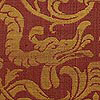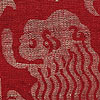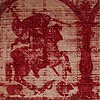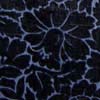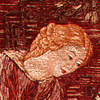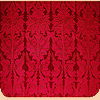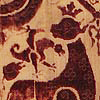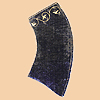 |

1300a
Antique Italian Embroidery
17th Century
Velvet Embroidery with a silver thread and very unique Chenille work.
This magnificent
velvet embroidery was made for Habsburg Dynasty Circa 1282-1918
Proserpina with
husband Pluto.
PROSERPINA
Circa 1650
Size 84 " x 60"
Size 214 x 153cm
Details Images Top & Below
Italian Textile
History

|
 Antique Italian Velvet
Antique Italian Velvet

The myth, She is the Roman equivalent of Persephone. Her name
comes from Proserpine meaning "to emerge". She was the
daughter of Ceres (Greek, Demeter) and Jupiter (Greek, Zeus),
who were brother and sister. Proserpina was in Sicily, at the
fountain of Aretusa near Mount Etna, when Pluto (Greek, Hades)
came out from the underworld stricken with love from an arrow
ordered by Venus, (Greek, Aphrodite) and abducted Proserpina in
order to marry her and bring her to live in his Kingdom, the Underworld,
of which she became Queen. Her mother Ceres, the Goddess of grain
and of the Earth, was devastated and went looking for her daughter,
but to no avail. In her desperation, Ceres angrily stopped the
growth of fruits and vegetables on the Earth. Worried, Jupiter
sent Mercury (Greek, Hermes) to order Pluto (Jupiter's brother)
to free Proserpina. Pluto obeyed, for he had made her eat pomegranate
seeds (symbol of fidelity in marriage). For every seed she had
eaten during her stay in the Underworld, she would have to return
for a month each year. She had eaten six, and for six months she
must return to Pluto, and for the remaining months, be reunited
with her mother, Ceres. So this is the reason for Spring and Summer:
when Proserpina comes back to her mother, Ceres decorates the
Earth with welcoming flowers and warms it with sunshine; but when
Proserpina returns to her husband, Ceres brings the cold and bare
Fall and Winter.
The Latin Inscription reads, "Six months with her Beloved
husband Pluto".
From 1914 to 1918, the noble and wealthy families of the Habsburg
Empire sold their art collections and things of worth because
of WW I. As the war dragged on for nearly 4 1/2 years all the
major European powers had to restructure their economies in order
to fight an industrialized "total war" of attrition.
Things of great value were bought cheap, art and luxury items
were no longer valuable in a collection. Family heirlooms and
keepsakes were sold to in order to maintain an amount of wealth.
At this time, one of the only groups of people sustaining their
wealth and influence were the Jews. Ida Jolles, a Jewish needlepoint
factory owner probably purchased these things in Vienna at a a
fraction of its value from one of these noblemen within the Habsburg
family. Thus, these tapestries passed from their intended royal
owners to a wealthy Jewish woman.
These tapestries deal with the marriage of a man and a woman and
the woman's submission to her husband as lord and god. In the
Habsburg Empire marriage was held in very high regard, being the
sole way they preserved their family's power. Women who married
into the Habsburg families were marrying noblemen, kings, princes
and dukes, and were to live according to their husband's word.
These tapestries acknowledge that concept and were probably given
as gifts to a lord or king and his wife for their wedding.
The griffin is associated with Justice and also with the sun.
Along the top of the tapestries are the griffins with full bodies,
probably symbolizing the God Apollo, or just the concept of light
and truth. The Griffins appearing on the bottom of the tapestries,
like the one shown above, are vegetable, or still and are growing
vines and flowers from their bodies; this relates more to the
other side of Apollo, Dionysus. Dionysus signifies rebirth and
life. But also Nemesis, which is not all together bad, it only
means 'you get what you deserve'. Nemesis is ultimately fate.
The design of the crown embroidered onto both of these pieces
may shed some further light on the origin of them. The presence
of cornucopia is symbolic of bounty and wealth. It's probable
that its meaning on these tapestries is a wish of good luck and
prosperity.
|  |
|
| |
|
|
